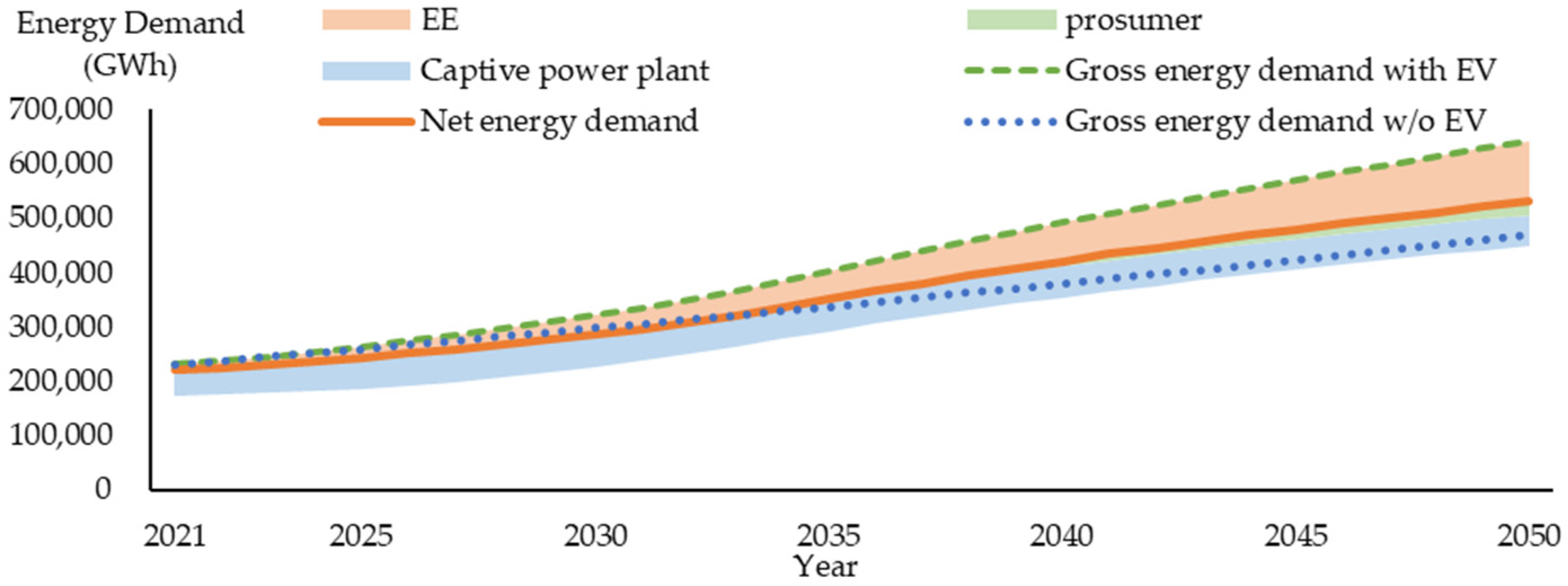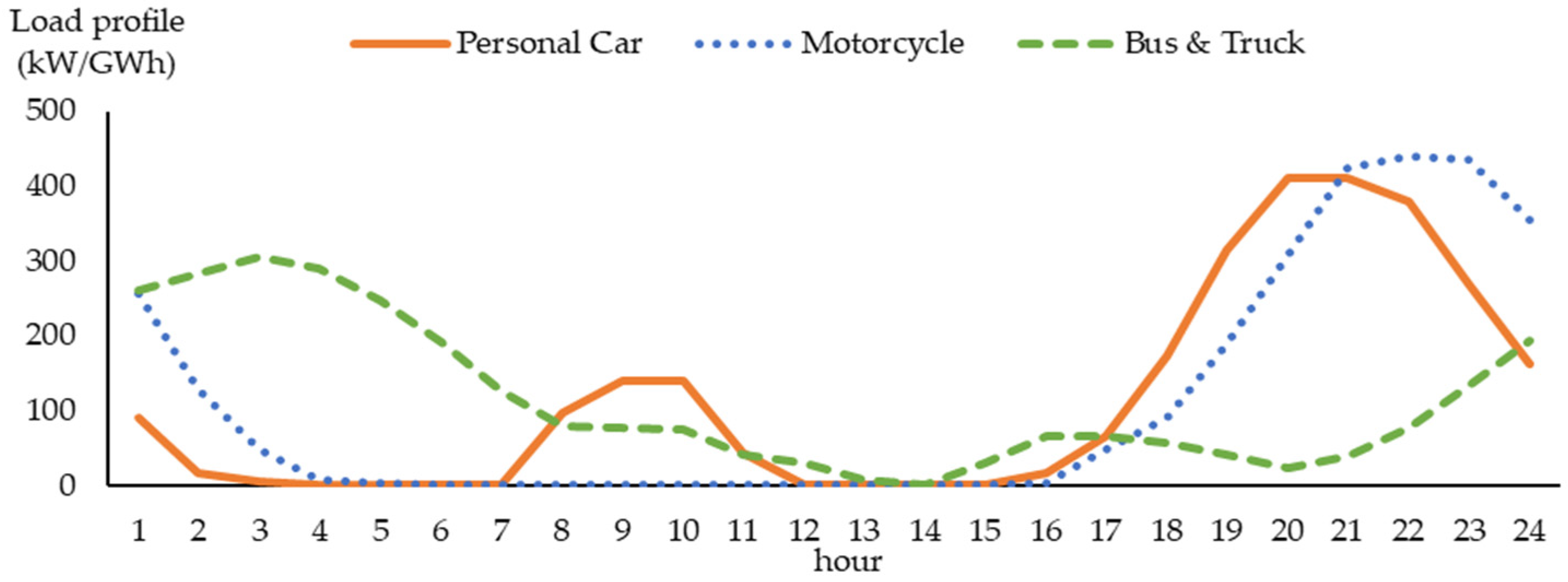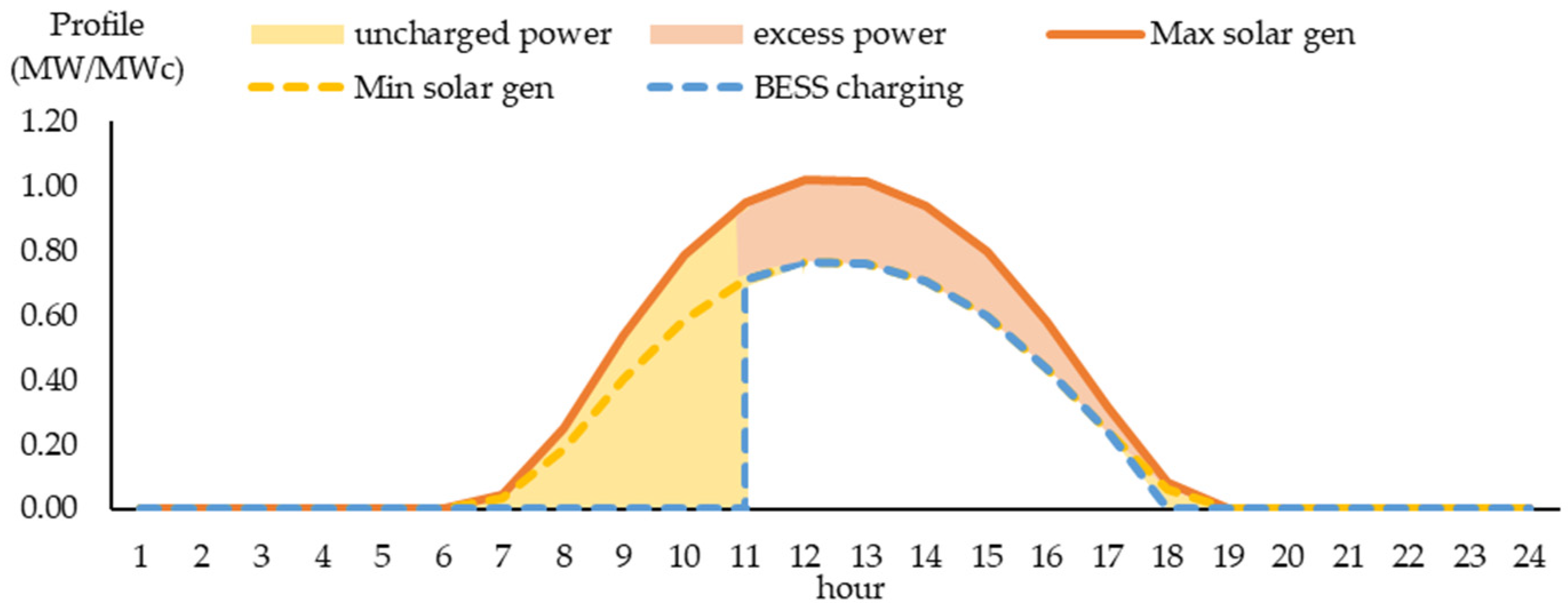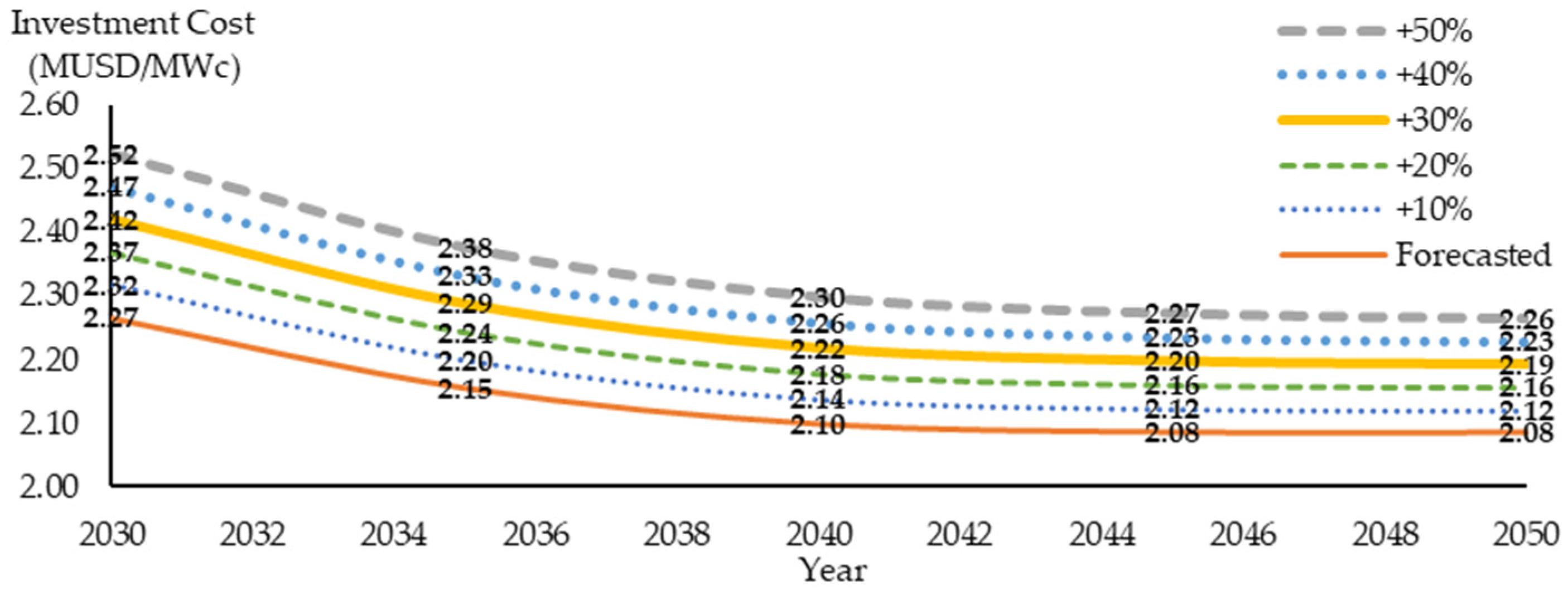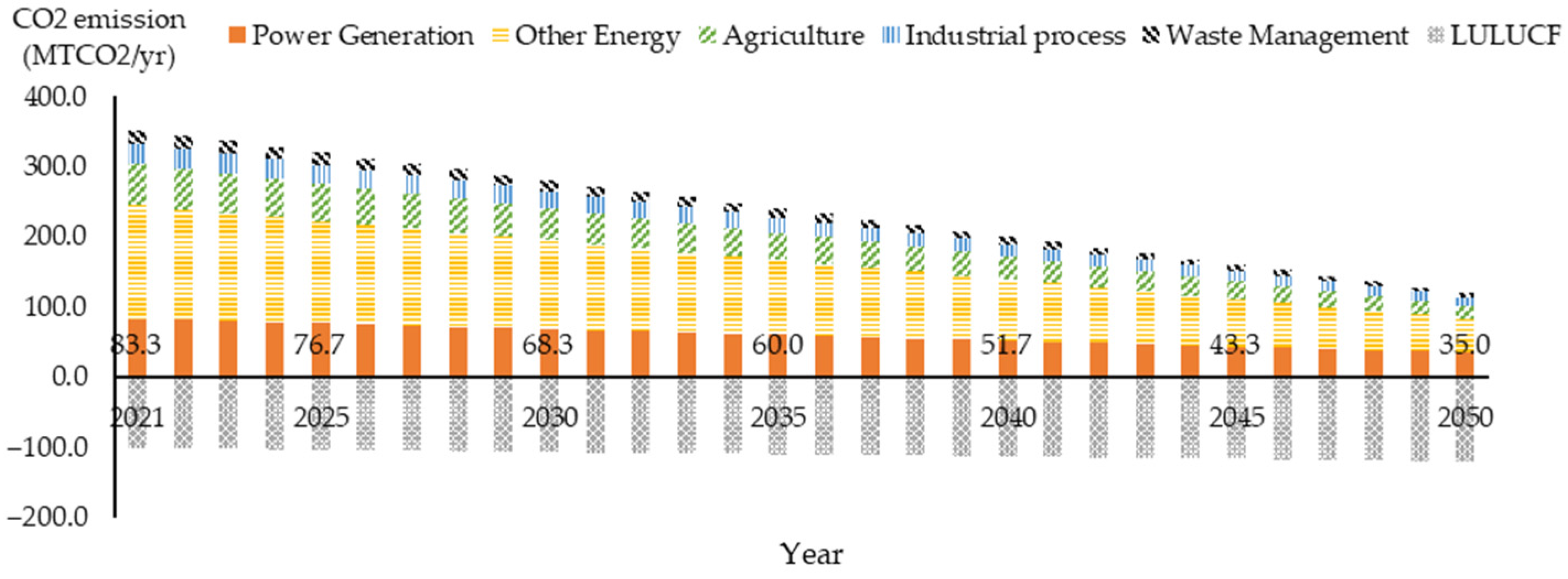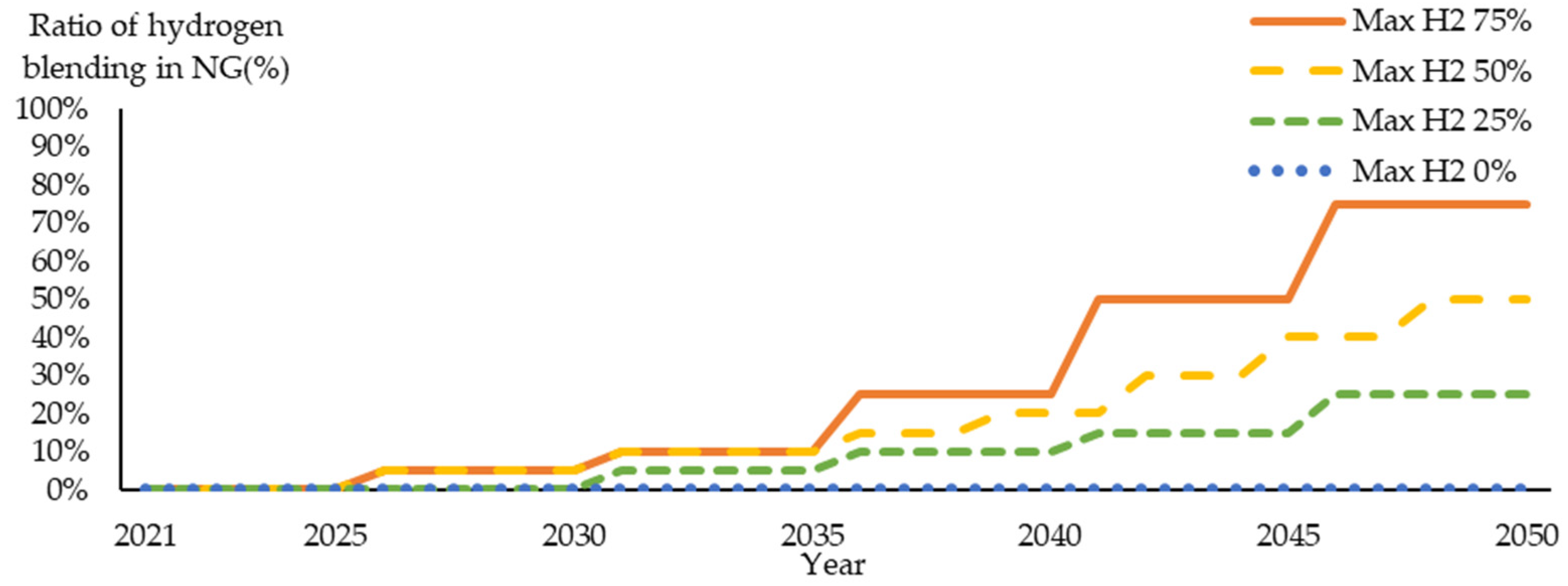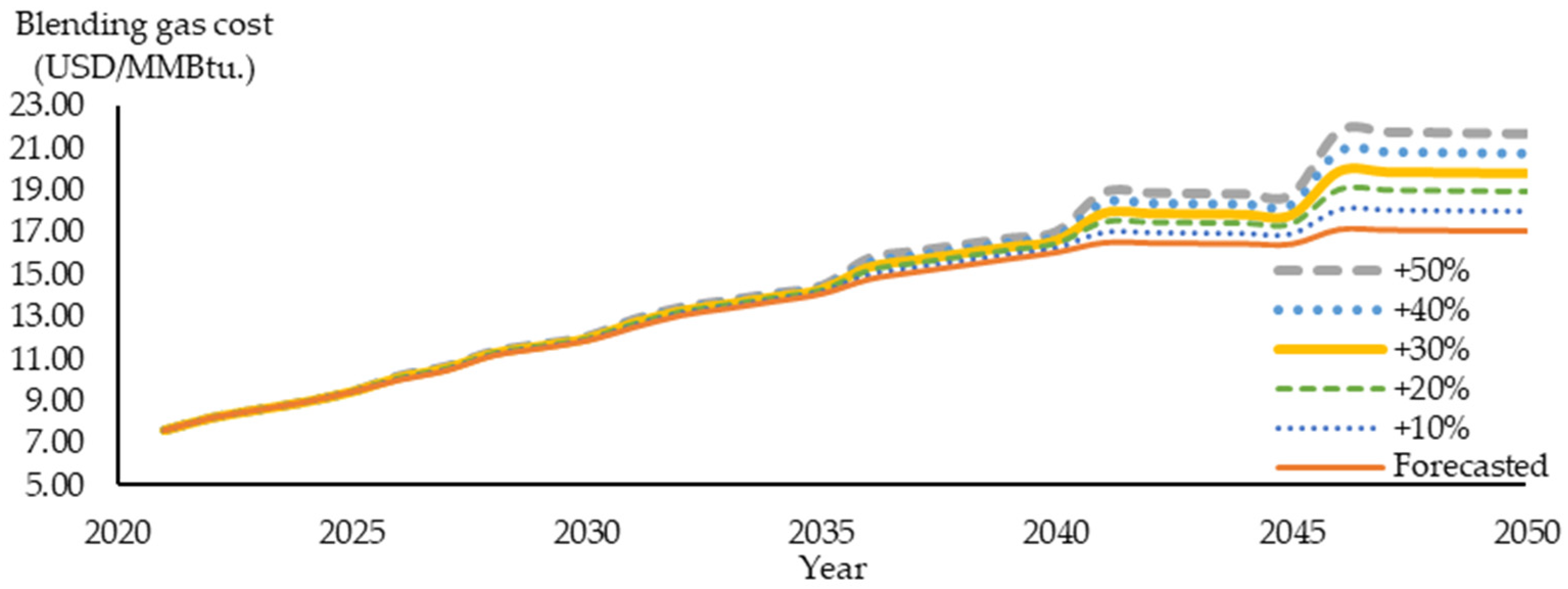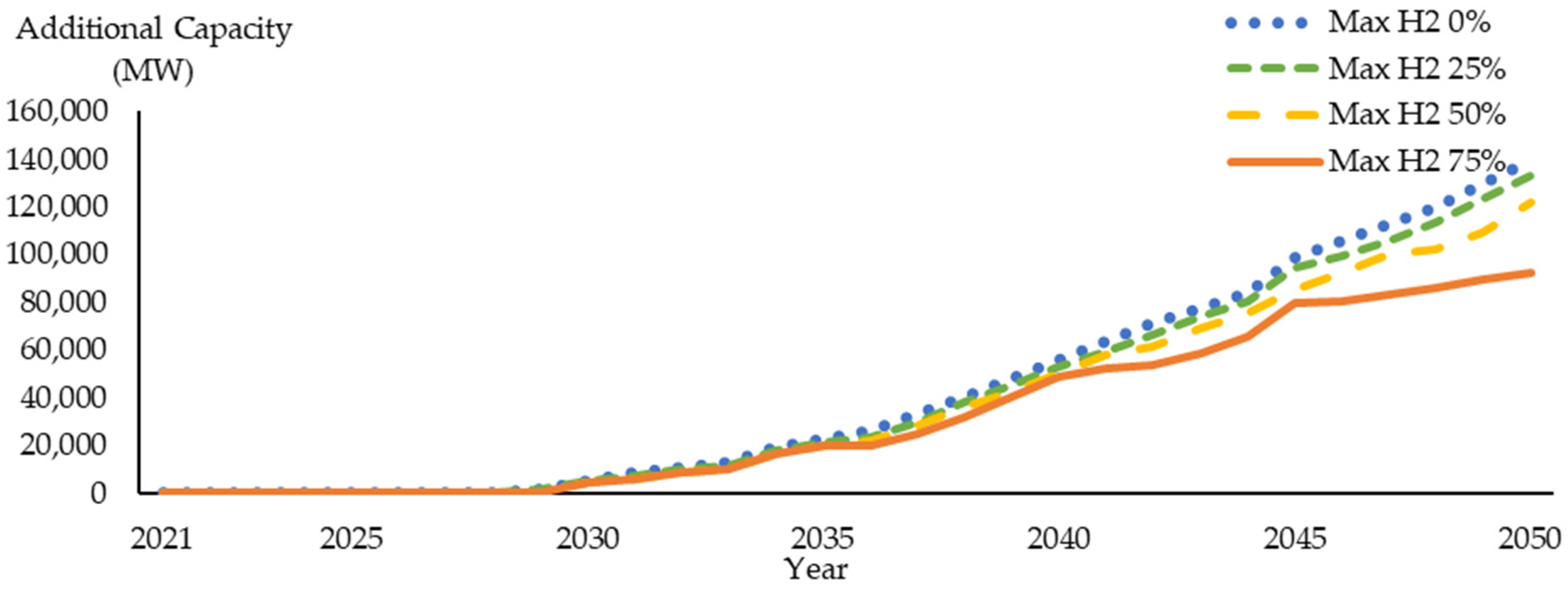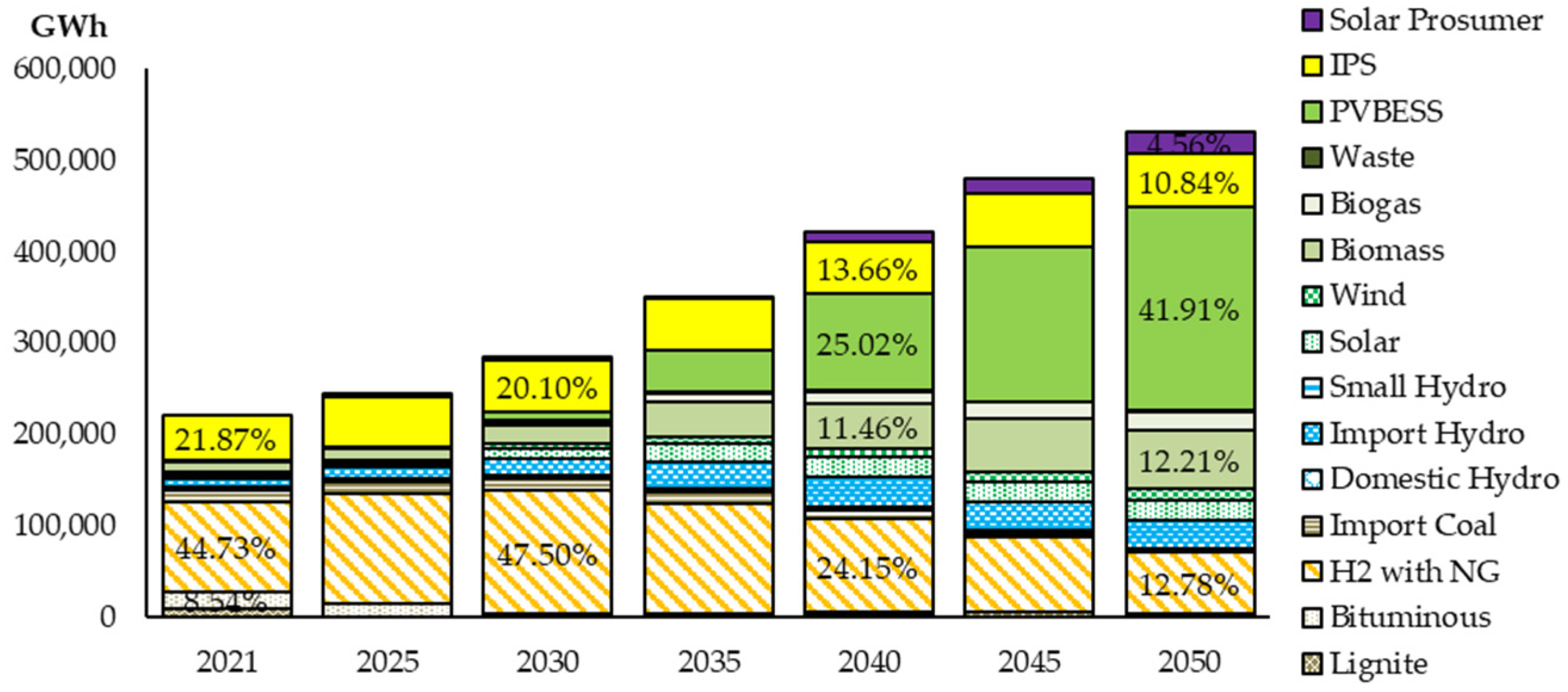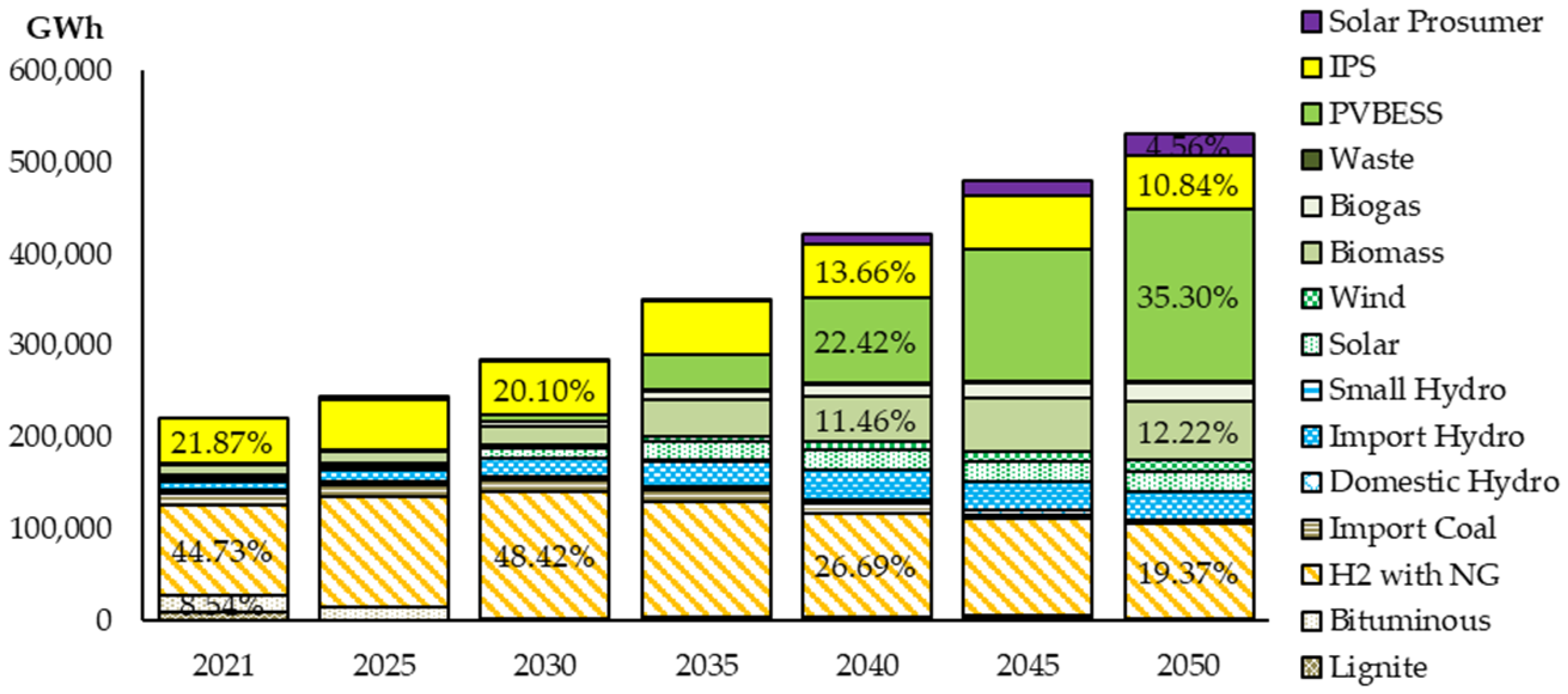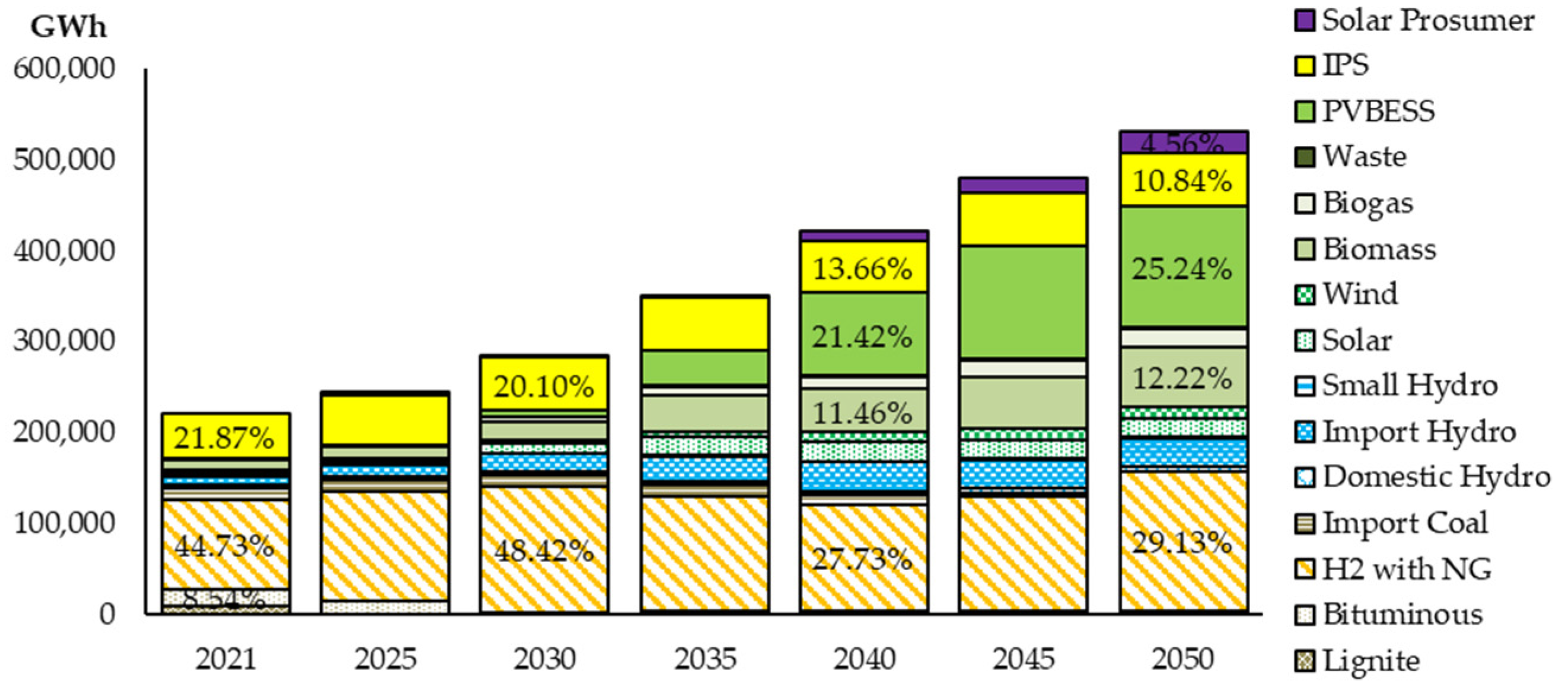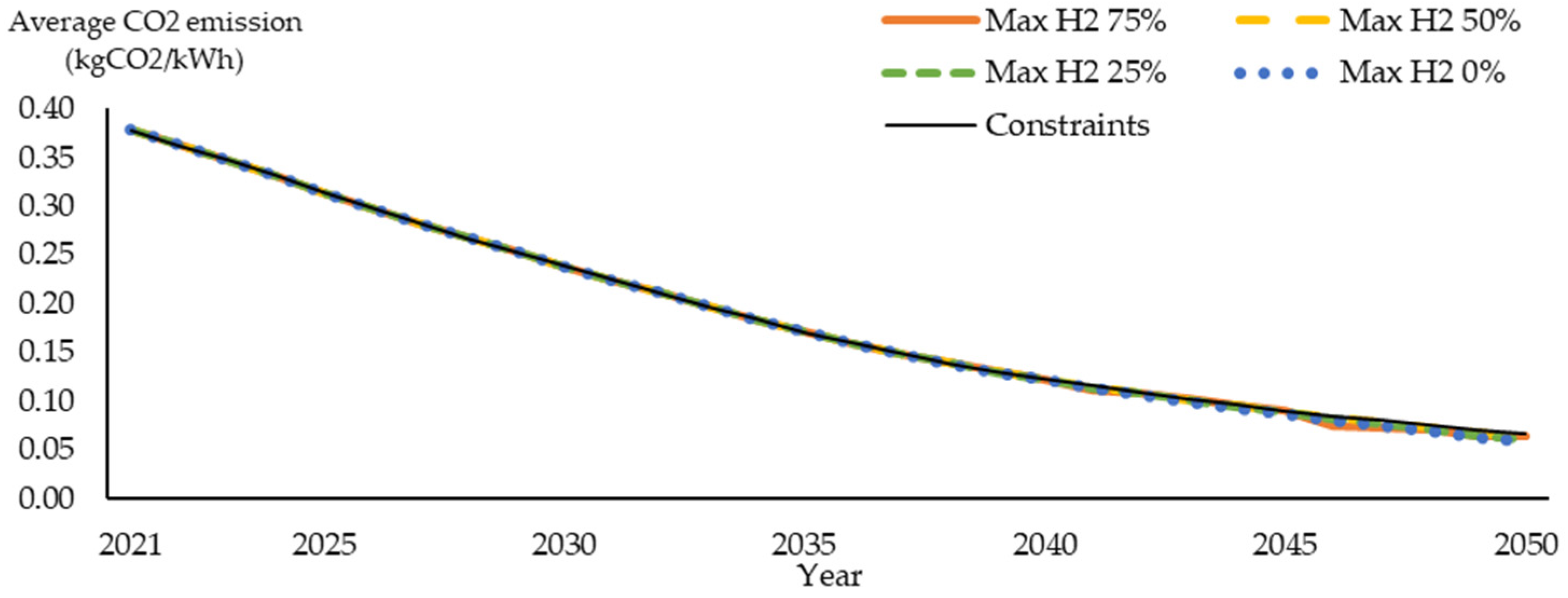1. Introduction
Global warming is one of the most important problems facing contemporary society. To avoid the potentially serious adverse impact of climate change, the International Panel on Climate Change (IPCC) report recommends that the rise in the global average surface temperature should be limited to no more than 1.5 °C above pre-industrial levels by reaching net zero carbon emission around the year 2050 (2045–2055 interquartile range) [
1]. To achieve this goal, the Glasgow Climate Pact was agreed upon by all participants at the 26th session of the Conference of the Parties to the United Nations Framework Convention on Climate Change (COP 26); global carbon emissions must be reduced to net zero around mid-century [
2]. Thus, rapid, deep, and sustained reductions in global greenhouse gas emissions are required.
As for Thailand, aggressive remarks were made by Thailand’s prime minister that Thailand is aiming to reach carbon neutrality in 2050 and net zero emission in or before 2065 [
3]. This target is quite aggressive compared to an emissions reduction of 20% from the projected business-as-usual (BAU) level mentioned in Thailand’s Nationally Determined Contribution (NDC) 2030 emissions target [
4], and the carbon neutrality target in 2065 stated in Thailand’s Long-Term Low Greenhouse Gas Emissions Development Strategy (LT-LEDS) [
5]. Thus, achieving 2050 carbon neutrality and 2065 net zero emission requires further efforts to reduce greenhouse gas (GHG) emissions in Thailand.
According to Thailand’s LT-LEDS, the total GHG emissions in 2016 were 354 MtCO2eq. The largest contributor was the energy sector (grid-connected electricity and heat generation), accounting for 30.96% of the total. The second largest GHG emissions contributor was the transportation sector, accounting for 19.26%. These two sectors account for more than 50% of Thailand’s total GHG emissions. Thus, GHG emissions from these sectors need to be greatly reduced to achieve the 2050 carbon neutrality and 2065 net zero emission targets. Although many efforts have been made and many national plans have been developed, according to the scenario in LT-LEDS, Thailand will not achieve carbon neutrality until 2065 even with 120 MtCO2eq of GHG sink from land use, land-use change, and forestry (LULUCF) together using up to a 50% share of renewable energy. Thus, to provide possible pathways in the electricity sector toward Thailand’s carbon neutrality in 2050, plans and policies must be extended further and revised to meet the challenge. For example, increased usage of electric vehicles (EVs) and electricity generated from renewable energy resources can enhance Thailand’s efforts to meet the 2050 target. Moreover, the GHG sink from Thailand’s LULUCF may need to be increased to its maximum potential to minimize or neutralize net GHG emissions. Lastly, novel choices of power generation technologies must be considered and integrated into revised plans.
There are many options for GHG reduction in the energy sector. Expanding the use of renewable energy is the most well-known option, as evidenced by the fact that increasing the share of renewable energy in electricity generation is the target of many countries and regions, e.g., 50% for Thailand [
6,
7], 40% by 2030 for European Union [
8], 100% by 2035 for the United Kingdom [
9], and 40% by 2030 and then 80% to achieve carbon neutrality by 2060 for China [
10,
11].
Although many renewable energy sources are almost GHG free, the intermittency of renewable energy generation, especially with solar PV and wind power, creates variability on the supply side, which makes the task of balancing the supply and demand in the system (with high levels of variable renewable energy (VRE) penetration) more challenging [
12]. To mitigate this variability and unpredictability, battery energy storage systems (BESSs) have been introduced in an effort to develop sustainable solutions that enable generation systems to integrate a high share of variable renewable energy [
13]. PV in combination with BESS is one of the main interests in this paper.
In the transportation sector, electrification based on the replacement of internal combustion engine (ICE) vehicles with EVs is one of the best available options due to the difference in the efficiency of ICE vehicles (20–25%) [
14] and electric motors with batteries in EVs (70–80%) [
15]. Moreover, the electricity used by EVs can be produced by renewable resources with no GHG emissions compared to the petroleum fuel used in ICE vehicles. Lastly, with its built-in battery and V2G concept, an EV may be able to serve as part of an ESS to support the production of electricity from renewable resources in the future [
16].
As for alternative fuel, hydrogen or hydrogen blending in existing natural gas networks has become an important alternative energy since combustion of hydrogen does not produce carbon dioxide and other greenhouse gases [
17]. Studies of hydrogen blending into the natural gas network have recently become popular [
18]. Moreover, investments in hydrogen-tolerant infrastructure are planned in many countries, e.g., the United States [
19], Germany [
20], Japan [
21], and the United Kingdom [
22]. However, the blending of hydrogen into natural gas networks also causes a reduction in the heating value of the mixed gases. Currently, efficient and safe operation can be achieved with up to 20% hydrogen by volume [
23,
24].
To achieve carbon neutrality, GHG emissions in hydrogen production must also be considered. At present, most hydrogen is produced from non-renewable processes, especially the steam reforming of methane (SRM) [
25], which releases carbon dioxide as a by-product (Gray Hydrogen) since the production of hydrogen from electrolysis is less efficient [
26] and unsustainable in the short term [
27]. Thus, carbon capture, utilization, and storage (CCUS) must be incorporated into these systems to reduce GHG emissions from SRM processes, making this hydrogen generation a lower carbon process (Blue Hydrogen) [
28] with a competitive price [
29]. The development of Blue Hydrogen projects is being pursued by many energy firms, for example, ExxonMobil [
30], Shell [
31], and Technip Energies [
32]. However, if net zero emission is to be achieved, the use of hydrogen, especially electrolysis-based hydrogen generated using renewable energy (Green Hydrogen), may need to be expanded rapidly [
33].
Finally, GHG sinks are also an option for the reduction of net GHG emissions. Since plants and trees absorb carbon dioxide as they grow, land use for agriculture and forestry can be developed to absorb carbon dioxide emitted from other sectors [
34]. Carbon dioxide emissions can also be reduced by CCUS applications, which capture carbon dioxide either directly from its sources or from the atmosphere. However, CCUS technology development at present is quite challenging due to the variation in exhaust emissions from carbon dioxide sources and the loss of efficiency represented by the energy penalty [
35]. Thus, commercialization of CCUS with power generation is still ongoing [
36].
The aim of this paper is to propose the possible pathways to achieve carbon neutrality in Thailand by 2050, from which the lesson learned may provide crucial information for policy makers in other countries to achieve carbon neutrality in their system. In this paper, Thailand’s long-term electricity demand will be forecast based on available data regarding the country’s official GDP [
37] and population [
38] projections. To provide enough supply for the demand forecast, new power generation technologies will need to be incorporated into these plans along with several planning constraints, e.g., reliability level, fuel mix, and carbon dioxide emission. Another contribution of this paper is to propose techniques to enhance the multi-period linear programming model developed in [
39], with the ability to integrate new electricity generation technologies having low emission, e.g., solar PV with battery and hydrogen blending in natural gas, into the generation expansion planning. Then, four scenarios with different levels of hydrogen blending in natural gas are analyzed and possible plans for generation expansion leading to Thailand’s carbon neutrality target in 2050 are discussed.
The rest of this paper is organized as follows:
Section 2 describes the planning methods used in developing the proposed plans.
Section 3 presents the data and assumptions used as an input to the method.
Section 4 describes the proposed plans developed from items discussed in
Section 3. In
Section 5, discussions and comparisons between the proposed plans are provided. Finally, conclusions are given in
Section 6.
3. Materials
In this section, the data and assumptions used to prepare a generation expansion plan for carbon neutrality by 2050 in Thailand’s electricity sector will be presented. Firstly, Thailand’s current plans and policies to reduce GHGs emissions will be presented. Secondly, Thailand’s system demand forecast (2021 to 2050) will be described. Then, Thailand’s power system and planning assumptions will be provided. Lastly, planning constraints such as carbon dioxide emissions and reliability constraints will be indicated.
3.1. Thailand’s Plans and Policies to Reduce GHGs Emissions
There have been many efforts to limit Thailand’s GHG emissions, especially from the electricity and transportation sectors. According to Thailand’s LT-LEDS, 64.20 MtCO
2eq was reduced from Thailand’s projected BAU level in 2019 through implementation of Thailand’s Nationally Appropriate Mitigation Actions (NAMAs). Moreover, additional actions are planned to further reduce Thailand’s GHG emissions. For example, it is mentioned in the Energy Efficiency Plan 2018–2037 (EEP2018) [
41] that the Energy Intensity is now targeted to be reduced by 30% by 2037 compared to the 2010 projected BAU. According to Thailand’s Alternative Energy Development Plan 2018–2037 (AEDP2018) [
6], a renewable energy generation capacity of 29,411 MW should be commissioned into the grid by 2037. Moreover, the target for average carbon dioxide emissions from electricity generated for the electricity grid shall be continually decreased from 0.442 kgCO
2/kWh in 2020 [
42] to 0.271 kgCO
2/kWh by 2037, as detailed in PDP2018 [
43].
In the transportation sector, a national electric vehicle roadmap was developed in 2015 [
44]. Moreover, various incentives have been provided to attract foreign investment in the EV industry. Recently, a “30/30 policy” was announced to promote EV manufacturing, i.e., at least 30% of total domestic vehicle production in Thailand shall comprise EVs by 2030 [
45]. With this policy, at least 725,000 electric passenger cars and pickup trucks and 675,000 electric motorcycles shall be produced in Thailand annually by 2030 [
46].
3.2. System Demand Forecast
To forecast future system demand, i.e., gross electricity peak demand and energy demand (captive power plant load and prosumer load included; a prosumer is an individual who both consumes and produces electrical energy), not only demand portfolio, load factor [
43], and energy elasticity [
47] are considered, but related forecast data, i.e., estimation of decrease in population [
38] and projection of GDP growth [
43], are also taken into account. This forecast data is combined with Thailand’s actual full-year hourly load curve of 2017 (base year) in order to create an hourly load pattern from 2021 to 2050. This hourly load pattern will be used as the load model in generation expansion planning. The demand forecast at this state is shown as the blue dot line in
Figure 2 and
Figure 3.
Since this system demand forecast is based on the load characteristics in 2017, several adjustments must be carried out to ensure that only the net demand that will need to be served by the generation system is considered, and that future load characteristics are represented in the load model. Firstly, while EV promotion is the main method to reduce GHG emissions in the transportation sector, there was almost no EV load in Thailand in 2017 [
48]; therefore, demand from EVs shall be added into the load model to represent future EV use. This demand is forecast annually from the EV usage forecast of each type of vehicle, i.e., personal cars, pickup trucks, motorcycles, buses, and heavy-duty trucks. Then, this is converted into multiple load profiles with corresponding charging patterns for each type of vehicle [
49]. Since the expected future energy usage per EV unit in each year varies according to the assumption of driving range improvement, the charging profile of EVs in kW per GWh demand of EV as shown in
Figure 4 is modeled and used in planning. Each EV charging profile shown in
Figure 4 is then multiplied by the future EV demand, such as 103,086 GWh for a personal car in 2050. Then, all profiles are added together to create an EV total demand profile. Next, the obtained EV total demand profile is added to the hourly load model. The demand forecast with EV load is shown as a green dashed line in
Figure 2 and
Figure 3. From
Figure 2, it is clear that EV demand in 2050 accounts for 27% of gross demand.
Next, the load is reduced to account for improved energy efficiency (EE) of the system, based on EEP2018 [
41]. As the EEP2018 ends at 2037, the energy intensity is projected to fall by the same trend from 2038 to 2050. Thus, the reduction in demand attributable to EE can be forecast and is shown as an orange solid line. Finally, the generation capacity of captive conventional power plants and prosumers comprising solar PV units for self-consumption is forecast. In this forecast, residential rooftop PV systems up to 10,000 MW will be installed by 2037 [
50]. Some of these rooftop PV systems are expected to be integrated with BESS in order to fully utilize generated energy as mentioned in [
50,
51,
52]. Generation profiles created from the capacity forecast of these units will be deducted from the hourly load model, since these captive power plants and prosumer generation units will be used to supply their demand directly. The forecast values of EE, captive power plants, prosumers, and EV demand can be found in
Appendix A.
3.3. Generation System Data and Assumptions
In this subsection, information about generation data, including commissioning and retiring dates for existing generation units, committed generation units, additional renewable energy generation units, and candidate generation units, is provided. This information is used to create the system generation model for generation expansion planning.
3.3.1. Existing Generation Unit
In this paper, generation units as well as PHS as of 31 December 2020 is used as the initial (existing) system for generation expansion planning. The names of existing units, their capacity, and commissioning dates can be found in the database of Electricity Generating Authority of Thailand (EGAT) [
53,
54,
55] and the database of the Energy Regulatory Commission (ERC) [
56]. A summary of these data can be found in
Appendix B.
3.3.2. Committed Generation Unit
Committed generation units are generation units that are already planned to be commissioned into the generation system. These units can be divided into two groups, which are committed units with signed contracts and committed units according to policy or plans. The list of units with signed contracts can be found in PDP2018rev1 [
43], the EGAT database [
53,
54,
55], and the ERC database [
56]. Additionally, renewable energy capacity that will be commissioned to achieve the renewable energy target can be found in AEDP2018 [
6]. A summary of these data and retired units can be found in
Appendix C of this paper.
3.3.3. Additional Renewable Energy Generation Unit
Recently, the National Energy Policy Committee (NEPC) of Thailand reached a conclusion regarding the policy direction to increase the share of renewable energy from new generation units to a level of at least 50% of additional capacity [
7]. Thus, additional renewable energy generation units on top of those of the AEDP2018 will be commissioned into the system. Given that solar PV prosumer capacity forecast is at its potential, and considering potential renewable energy resources in Thailand, additional biomass, biogas, and wind power generation units are planned for annual commissioning from 2030 to 2050, as shown in
Figure 5, in order to increase the share of new generation units powered by renewable energy to the 50% target level.
Moreover, the imported power from Lao PDR, mainly from hydropower generation, is planned to increase from 9000 MW to 10,500 MW, to reduce the amount of GHG generated from electricity generation in Thailand. Thus, 1500 MW of imported hydropower generation is planned. These additional units are mentioned in
Appendix C.
Lastly, to fully utilize the energy generated from renewable energy sources, it is assumed that BESS will be installed, starting from 2026. In this study, the ESS is also planned to act as a part of the spinning reserves. Hence, the storage capacity (MWh) of the BESS (with the C-rate equal to 1) in each year is set to 5% of net peak demand (MW), from 2030 onward. Thus, the additional and cumulative storage capacity of BESS units can be shown as in
Figure 6. Because the BESS is expected to be used for approximately 1 cycle per day, the estimated lifetime of the BESS components is 20 years. After that, the BESS components will be replaced accordingly. The parameters of ESS units, i.e., PHS and BESS, are provided in
Appendix D.
3.3.4. Candidate Generation Unit
In the planning stage [
39], more generation units will be installed in the system when
the reliability criterion violates the target reliability level, or
there is no optimal solution provided by unit commitment/economic dispatch.
If more generation units are needed, those with the lowest unit cost will be selected from the set of pre-defined available generation types. However, those units must meet all the planning constraints, such as fuel mix or maximum carbon dioxide emissions. In this study, to comply with the carbon neutrality target, only two generation units with zero or near-zero emissions were selected as candidate units. Uncertainty of the cost of the electricity generated from these candidate units was also considered. This uncertainty is described in the next section.
The combination of solar PV and BESS (PVBESS) comprises the first candidate unit. In this study, this unit is designed to supply power at its contracted capacity for 4 h a day in every season of the year. Therefore, the size of the generating capacity must be selected with consideration of the worst solar irradiance of the year. Moreover, the BESS must be able to be charged during a fixed interval from 11:00 to 18:00 (7 h) to comply with the PV generation profile. During this period, the BESS of the PVBESS unit will not allowed to discharge. However, on some days, if there is PV power in excess of the predefined charging power of the BESS unit, this excess power will directly flow into the system. The PV generation profile and BESS charging profile are shown in
Figure 7. In this study, a PVBESS unit with the contracted capacity of 1 MW with 4 h of operation a day consists of 1.7 MW of PV combined with 5.13 MWh of BESS.
Although the investment cost of PVBESS is currently high due to the high cost of the battery, this cost is expected to fall in the future [
57,
58]. Thus, in this study, PVBESS units are considered as a candidate from 2030 onward, and the relevant investment cost is assumed to decline. Uncertainty of the BESS cost is also considered in this study. The probability of the projected cost is 0.5, and it is assumed that future BESS costs may be 10% to 50% above this projected value, with the associated probability shown in
Table 1. Given this, future PVBESS costs can be calculated and are shown in
Figure 8. PV and BESS cost projections are provided in
Appendix E.
- 2.
Combined cycle gas turbine unit using natural gas blended with hydrogen
Another candidate unit considered in this study is the conventional combined cycle gas turbine (CCGT) unit. Since carbon neutrality must be achieved, fuel gas used in the system is hydrogen blended with natural gas (mixed gas). The investment cost of the candidate CCGT unit is fixed throughout the planning horizon (2021 to 2050), but the efficiency of the new power plant is expected to be improved every year (i.e., its heat rate is projected to decrease), as shown in
Figure 9.
3.4. Planning Constraints
In this study, to ensure availability, reliability, and carbon neutrality of the generation system, the following constraints are considered in generation expansion planning.
Because the power system will comprise a high share of VRE, i.e., wind and solar, which vary by time of day and season, a full-year hourly generation profile is selected as the model for these VRE units, since it can represent their time-variation/seasonal characteristics. Thus, to ensure system adequacy throughout the year without capacity shortage, a full-year hourly energy and power balance between supply, storage, and demand is applied to every year in the planning horizon of this study.
Loss of Load Expectation (LOLE), which is the number of days that capacity shortages are expected, will be used as the main reliability constraint, since the intermittency of variable renewable energy can be represented. In this study, the LOLE of the system must not be greater than 0.7 day/year for every year in the planning horizon.
The carbon dioxide emission constraint for generation expansion planning in this study must be aligned with the carbon neutrality target in 2050. To create this emission constraint for each year in the planning horizon, the data relating Thailand’s GHG emission by sector in tonCO
2eq in 2016, and at the carbon neutrality year mentioned in the LT-LEDS public hearing process, which is 35 MtCO
2, are used, as shown in
Figure 10.
With these data, the annual emissions of the electricity generation sector can be interpolated linearly and then allocated monthly based on projected monthly demand, since the planning is done monthly
3.5. Hydrogen Blending in Natural Gas
As mentioned in
Section 3.3.4, the fuel gas used in the generation system in this study is a blend of hydrogen and natural gas, in an effort to reduce carbon dioxide emissions. Since the current natural gas network cannot accept high concentrations of hydrogen, the proportion of hydrogen will be increased gradually throughout the planning horizon. This will allow retrofitting to be done, gradually enhancing the system-wide ability to make use of higher proportions of blended hydrogen. Hydrogen blending in the natural gas network can also reduce carbon dioxide emissions in not only the energy sector but also in others that use natural gas as fuel. The heating value, cost, and carbon dioxide emissions of each scenario are different and can be calculated by the following equations.
where:
is the price of hydrogen (USD/MMBtu)
is the high heating value of hydrogen, which is 325 Btu/scf
is the ratio of hydrogen in blended gas (%)
is the price of natural gas (USD/MMBtu)
is the high heating value of natural gas, which is 1000 Btu/scf
is the carbon dioxide emission factor of natural gas, which is 57.3 kgCO2/MMBtu
3.6. Carbon Capture, Utilization, and Storage
Although CCUS is recognized as one of the solutions for GHG emission reduction, its commercialization is still under development, as discussed in [
36]. Since carbon dioxide concentrations from the combustion process of CCGT power plants is quite low due to the percentage of nitrogen gas in the atmosphere, capturing carbon dioxide from this exhaust gas is costly and inefficient compared to exhaust gases from other process with higher concentrations [
35], such as steam methane reforming [
59]. Moreover, the investment and operation cost of CCGT with CCUS technologies is double compared to power plants without CCUS [
60]. Lastly, renewable energy with storage provides a more energetically effective approach to climate mitigation than constructing CCUS fossil-fuel power plants [
61]. Thus, in this study, the usage of CCUS in fossil-fuel generation units is not considered.
6. Conclusions
This paper discusses possible generation expansion plans for Thailand, which will enable the country to achieve carbon neutrality in the electricity sector by 2050, in accordance with the remarks made at the World Leaders Summit of COP 26. Thailand’s future electricity demand is forecast with disruptive technologies for both demand and generation. Four scenarios are set as options for planning, corresponding to variations of hydrogen concentration blended into the natural gas network. Since the use of CCUS in the electricity generation system is not considered in this study, there are only two options remaining, i.e., renewable energy or hydrogen blending in the natural gas network. Both of these allow production of electricity with less carbon dioxide emissions, which would help Thailand achieve the stated carbon neutrality target. Due to the limitations of bio-based resources and low average wind speed in Thailand, solar PV with BESS for load-shifting is the major renewable energy option with the potential for very large-scale installation (100,000 MW or beyond). Thus, options for additional units are limited to PVBESS and CCGT using mixed hydrogen and natural gas. The generation planning method used in this study follows the technique described in [
40] with a few modifications as explained in
Section 2. Then, four generation expansion plans were developed and compared. These expansion plans can be used for policy makers for the development of electricity generation systems with the carbon neutrality target of 2050.
In this study, it was found that the concentration of hydrogen blending in natural gas plays a critical role in the development of power generation expansion plans, considering carbon neutrality as the main target. Although Thailand’s carbon neutrality can be achieved without hydrogen blending in natural gas, a large area of land is required to install a large PVBESS capacity. Furthermore, the cost of electricity is higher without hydrogen blending in natural gas, due to the forecast high cost of BESS. Hydrogen blending with low concentration can reduce PVBESS capacity only marginally, since the carbon dioxide emissions of blended gas are reduced slightly. Thus, higher concentrations of hydrogen are needed to limit the areas required for PVBESS installation. Moreover, the scenario with higher concentrations of hydrogen results in a lower average cost of electricity. Finally, based on the sensitivity study, it was found that, at the end of the plan, if the costs of BESS and hydrogen do not decline as expected, or more expensive hydrogen such as green hydrogen is used, the average electricity cost will increase above the forecast cost only in the range of 0.07–0.40 THB/kWh or about 10%. This sensitivity analysis can provide crucial information to policymakers to ensure planning outcomes.
From this study, to achieve Thailand’s carbon neutrality in electricity generation systems by 2050, several tasks need to be done. Firstly, generation capacity from renewable resources needs to be increased to its potential. Secondly, only candidate generation units with low or no carbon dioxide emissions are allowed for generation expansion. Finally, without the use of a large land area, Thailand’s natural gas network needs to be retrofitted to enable usage of high concentrations of hydrogen. This study can provide guidelines and lessons learned for system operators or policy makers of other countries to develop their own pathway toward carbon neutrality. The method to integrate PVBESS into dispatch and reliability models for generation expansion planning is also provided in this study. Although details of a possible pathway toward Thailand’s carbon neutrality are provided in this study, in future work, the cost of natural gas network retrofitting still needs to be taken into account. This cost shall be compared with the cost of land use in other alternative options to find the most suitable pathway toward Thailand’s carbon neutrality.

